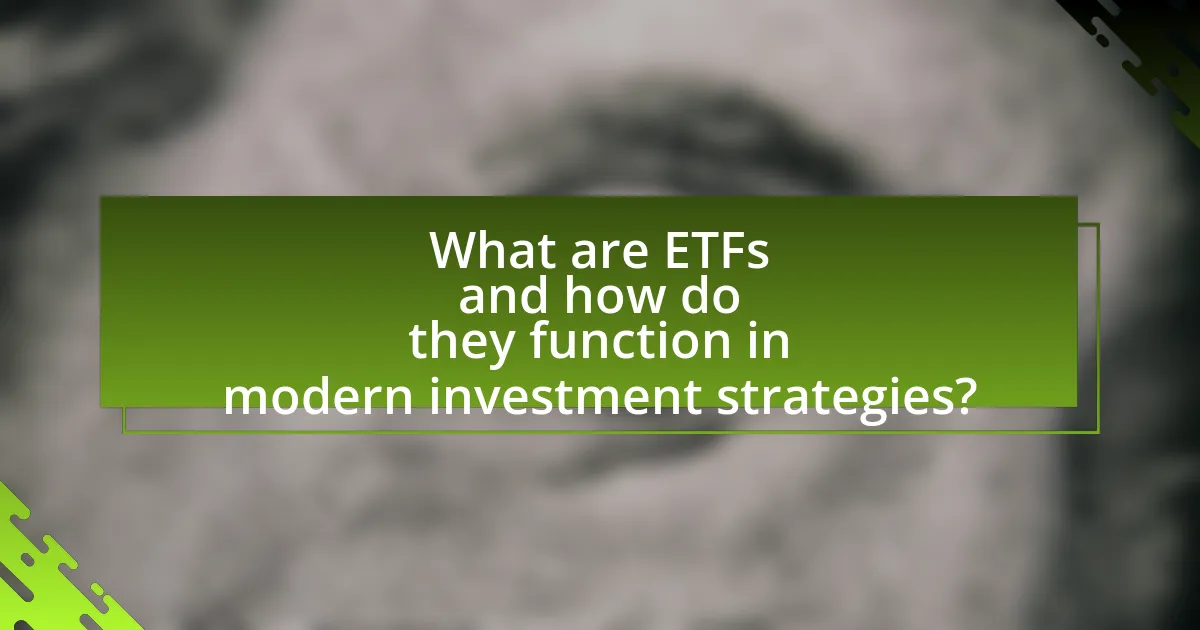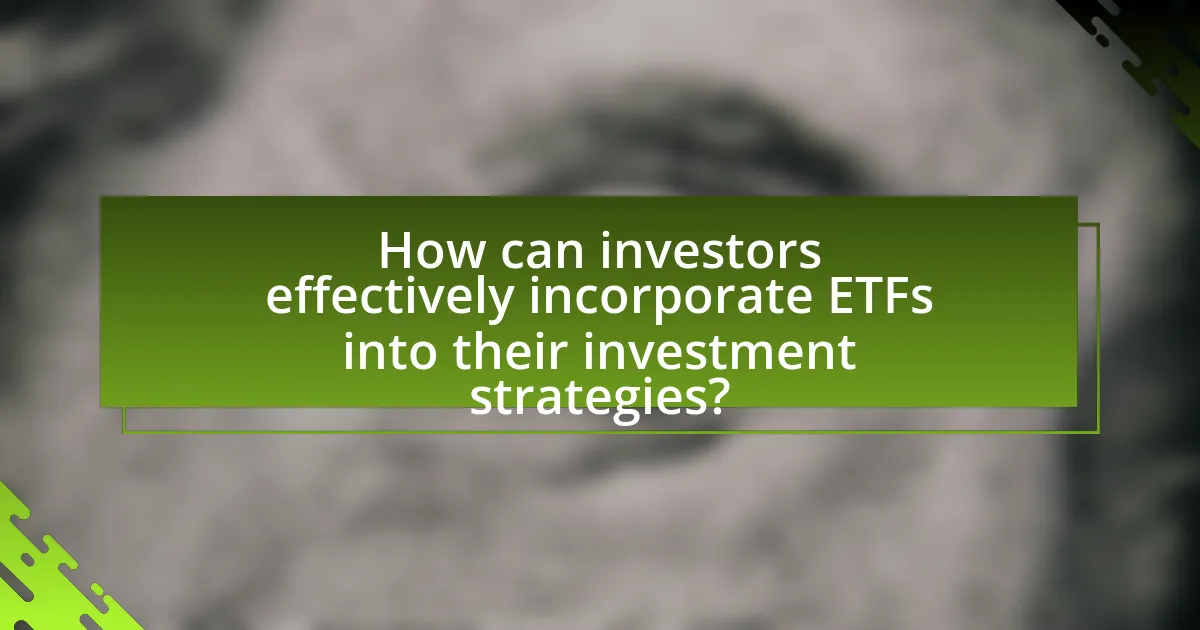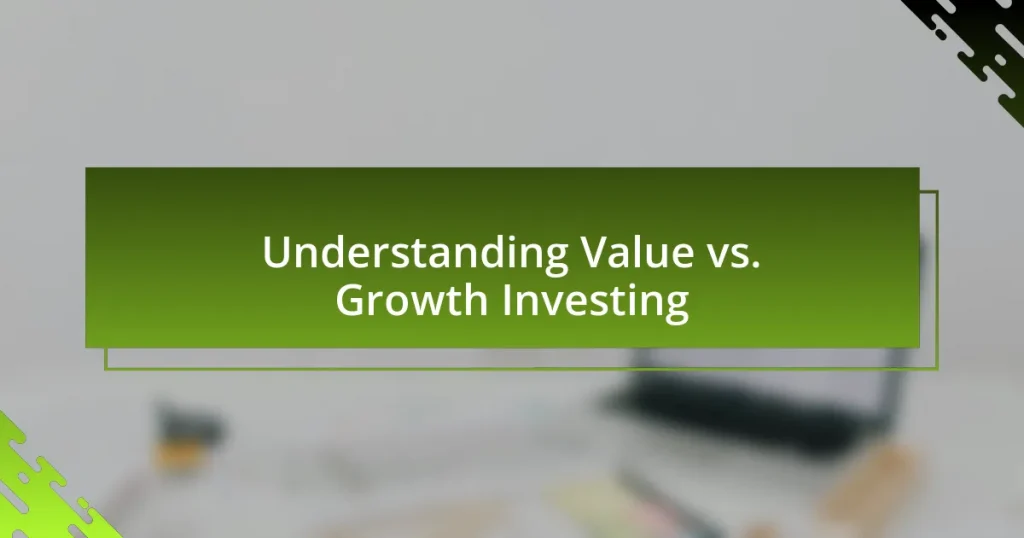Exchange-Traded Funds (ETFs) are investment funds traded on stock exchanges that pool investors’ money to create diversified portfolios of assets, such as stocks, bonds, and commodities. This article explores the functionality of ETFs in modern investment strategies, highlighting their liquidity, cost-effectiveness, and tax efficiency. Key characteristics of ETFs, their differences from mutual funds, and the various types of assets they can hold are discussed. Additionally, the article examines the growing popularity of ETFs among investors, their role in portfolio management, and strategies for risk management, while also addressing potential risks and best practices for selecting and utilizing ETFs effectively.

What are ETFs and how do they function in modern investment strategies?
ETFs, or Exchange-Traded Funds, are investment funds that are traded on stock exchanges, similar to individual stocks. They function by pooling investors’ money to purchase a diversified portfolio of assets, such as stocks, bonds, or commodities, which allows investors to gain exposure to a wide range of securities without having to buy each one individually.
In modern investment strategies, ETFs are utilized for their liquidity, cost-effectiveness, and tax efficiency. They typically have lower expense ratios compared to mutual funds, making them an attractive option for both retail and institutional investors. According to the Investment Company Institute, as of mid-2023, U.S. ETF assets reached approximately $6.5 trillion, reflecting their growing popularity in portfolio diversification and risk management. Additionally, ETFs can be used for various strategies, including hedging, tactical asset allocation, and sector rotation, allowing investors to adapt to changing market conditions efficiently.
What are the key characteristics of ETFs?
Exchange-Traded Funds (ETFs) are investment funds that are traded on stock exchanges, similar to individual stocks. Key characteristics of ETFs include diversification, as they typically hold a collection of assets such as stocks or bonds, which reduces risk compared to investing in single securities. Additionally, ETFs offer liquidity, allowing investors to buy and sell shares throughout the trading day at market prices. They also have lower expense ratios compared to mutual funds, making them cost-effective investment options. Furthermore, ETFs are tax-efficient due to their unique structure, which minimizes capital gains distributions. These characteristics make ETFs a popular choice for investors seeking a flexible and efficient way to gain exposure to various asset classes.
How do ETFs differ from mutual funds?
ETFs, or Exchange-Traded Funds, differ from mutual funds primarily in their trading mechanism and pricing structure. ETFs trade on stock exchanges like individual stocks, allowing investors to buy and sell shares throughout the trading day at market prices, which can fluctuate. In contrast, mutual funds are bought and sold at the end of the trading day at a price determined by the net asset value (NAV). Additionally, ETFs typically have lower expense ratios and greater tax efficiency compared to mutual funds, as they often utilize an in-kind redemption process that minimizes capital gains distributions. These structural differences make ETFs more flexible and cost-effective for many investors.
What types of assets can ETFs hold?
ETFs can hold a variety of assets, including stocks, bonds, commodities, and real estate. Specifically, equity ETFs primarily invest in stocks, while bond ETFs focus on fixed-income securities. Commodity ETFs typically track the price of physical goods like gold or oil, and real estate ETFs invest in real estate investment trusts (REITs) or direct real estate holdings. This diverse asset allocation allows ETFs to provide investors with exposure to different sectors and asset classes, enhancing portfolio diversification and risk management.
Why are ETFs becoming increasingly popular among investors?
ETFs are becoming increasingly popular among investors due to their low costs, tax efficiency, and diversification benefits. The average expense ratio for ETFs is significantly lower than that of mutual funds, often around 0.2% compared to 1% or more for actively managed funds. Additionally, ETFs typically generate fewer capital gains distributions, making them more tax-efficient. This combination of lower costs and tax advantages appeals to a broad range of investors, from retail to institutional. Furthermore, ETFs provide easy access to a diversified portfolio across various asset classes, allowing investors to spread risk effectively. According to the Investment Company Institute, as of mid-2023, U.S. ETF assets reached approximately $6 trillion, reflecting their growing acceptance and popularity in investment strategies.
What advantages do ETFs offer over traditional investment vehicles?
ETFs offer several advantages over traditional investment vehicles, including lower expense ratios, tax efficiency, and greater liquidity. Lower expense ratios are significant because, according to Morningstar, the average expense ratio for ETFs is around 0.44%, compared to 1.25% for actively managed mutual funds. This cost efficiency allows investors to retain more of their returns. Tax efficiency is another advantage, as ETFs typically generate fewer capital gains distributions due to their unique structure, which allows for in-kind redemptions. This results in lower tax liabilities for investors. Additionally, ETFs provide greater liquidity since they can be traded throughout the day on stock exchanges, unlike traditional mutual funds, which are only traded at the end of the trading day. This flexibility allows investors to react quickly to market changes.
How do ETFs provide diversification for investors?
ETFs provide diversification for investors by allowing them to invest in a broad range of assets within a single fund. This structure enables investors to gain exposure to various sectors, industries, or geographic regions without needing to purchase individual securities. For example, an ETF that tracks the S&P 500 includes shares from 500 different companies, thereby spreading risk across multiple holdings. This diversification reduces the impact of poor performance from any single investment, as the overall performance is averaged across all included assets. Studies have shown that diversified portfolios tend to have lower volatility and better risk-adjusted returns compared to concentrated investments.
What role do ETFs play in portfolio management?
ETFs, or Exchange-Traded Funds, serve as versatile tools in portfolio management by providing diversification, liquidity, and cost efficiency. They allow investors to gain exposure to a wide range of asset classes, including stocks, bonds, and commodities, without the need to purchase individual securities. For instance, a single ETF can track an entire index, such as the S&P 500, enabling investors to hold a diversified portfolio with minimal effort. Additionally, ETFs trade on exchanges like stocks, offering liquidity and the ability to buy or sell throughout the trading day. According to a report by the Investment Company Institute, as of mid-2023, U.S. ETF assets reached over $6 trillion, highlighting their growing importance in investment strategies. This combination of features makes ETFs a fundamental component of modern portfolio management.
How can investors use ETFs to achieve specific investment goals?
Investors can use ETFs to achieve specific investment goals by selecting funds that align with their desired asset allocation, risk tolerance, and investment horizon. For instance, an investor seeking growth may choose equity ETFs that track high-performing indices, while a conservative investor might opt for bond ETFs to preserve capital and generate income. According to the Investment Company Institute, as of 2022, U.S. investors held over $6 trillion in ETFs, reflecting their popularity for targeted investment strategies. This flexibility allows investors to diversify their portfolios efficiently, as ETFs typically hold a basket of securities, reducing individual stock risk. Additionally, the low expense ratios associated with ETFs make them a cost-effective option for achieving specific financial objectives.
What strategies can be employed with ETFs for risk management?
ETFs can employ several strategies for risk management, including diversification, hedging, and stop-loss orders. Diversification involves investing in a variety of asset classes or sectors through ETFs, which reduces exposure to any single investment’s volatility. For instance, a study by Vanguard indicates that a diversified portfolio can lower risk without significantly sacrificing returns. Hedging can be achieved by using inverse or leveraged ETFs that move in the opposite direction of the underlying index, providing a buffer against market downturns. Additionally, implementing stop-loss orders allows investors to automatically sell an ETF when it reaches a predetermined price, limiting potential losses. These strategies collectively enhance risk management in ETF investments.
How do market trends influence the use of ETFs?
Market trends significantly influence the use of ETFs by dictating investor behavior and asset allocation strategies. When markets are bullish, investors tend to favor equity ETFs to capitalize on rising stock prices, leading to increased inflows into these funds. Conversely, during bearish market conditions, investors often shift towards bond or commodity ETFs as a means of risk mitigation and capital preservation. For instance, in 2020, during the COVID-19 pandemic, there was a notable surge in demand for gold ETFs as investors sought safe-haven assets, resulting in record inflows of over $40 billion into gold-backed ETFs. This demonstrates how market sentiment directly impacts the types of ETFs that attract investment, reflecting broader economic conditions and investor confidence.
What are the potential risks associated with investing in ETFs?
Investing in ETFs carries several potential risks, including market risk, liquidity risk, and tracking error. Market risk refers to the possibility that the value of the ETF will decline due to overall market conditions, which can affect all securities within the fund. Liquidity risk arises when an investor cannot buy or sell shares of the ETF without causing a significant impact on its price, particularly in less-traded funds. Tracking error is the discrepancy between the ETF’s performance and the performance of its underlying index, which can occur due to management fees, trading costs, or other factors. These risks highlight the importance of thorough research and understanding before investing in ETFs.

What are the different types of ETFs available?
There are several types of ETFs available, including equity ETFs, bond ETFs, commodity ETFs, sector and industry ETFs, international ETFs, and thematic ETFs. Equity ETFs invest in stocks and can track specific indices like the S&P 500, while bond ETFs focus on fixed-income securities, providing exposure to government or corporate bonds. Commodity ETFs invest in physical goods like gold or oil, and sector and industry ETFs target specific sectors such as technology or healthcare. International ETFs offer exposure to foreign markets, and thematic ETFs focus on specific investment themes or trends, such as renewable energy. Each type serves distinct investment strategies and objectives, catering to diverse investor needs.
How do equity ETFs differ from bond ETFs?
Equity ETFs differ from bond ETFs primarily in their underlying assets; equity ETFs invest in stocks, while bond ETFs invest in fixed-income securities. This fundamental difference leads to varying risk profiles, with equity ETFs generally exhibiting higher volatility and potential for capital appreciation, whereas bond ETFs typically offer more stability and income through interest payments. For instance, as of 2023, the average annual return for equity ETFs has been around 10%, compared to approximately 3% for bond ETFs, reflecting the higher risk and reward associated with equities.
What are sector-specific ETFs and how do they function?
Sector-specific ETFs are exchange-traded funds that focus on a particular industry or sector of the economy, such as technology, healthcare, or energy. These ETFs function by pooling investors’ money to purchase a diversified portfolio of stocks within the targeted sector, allowing investors to gain exposure to that sector’s performance without needing to buy individual stocks. For example, the Technology Select Sector SPDR Fund (XLK) invests in companies from the technology sector, providing a way for investors to capitalize on trends in that industry. This structure enables investors to manage risk and achieve diversification while targeting specific market segments.
What are international ETFs and what benefits do they provide?
International ETFs, or Exchange-Traded Funds, are investment funds that hold a collection of assets from various countries outside the investor’s home country, allowing for diversified exposure to global markets. These funds provide several benefits, including diversification, as they enable investors to spread risk across different economies and sectors, reducing the impact of volatility in any single market. Additionally, international ETFs often have lower expense ratios compared to mutual funds, making them a cost-effective option for gaining exposure to foreign investments. According to a report by Morningstar, the average expense ratio for international ETFs is significantly lower than that of actively managed international mutual funds, which supports the cost-effectiveness claim. Furthermore, international ETFs offer liquidity, as they can be traded on stock exchanges throughout the trading day, providing investors with flexibility and ease of access to global markets.
What are thematic ETFs and how do they cater to niche markets?
Thematic ETFs are exchange-traded funds that focus on specific themes or trends in the market, allowing investors to target niche sectors such as renewable energy, technology innovation, or demographic shifts. These ETFs cater to niche markets by providing exposure to companies that align with particular investment themes, enabling investors to capitalize on emerging trends without needing to select individual stocks. For example, as of 2023, the global thematic ETF market has seen significant growth, with assets under management exceeding $300 billion, reflecting increasing investor interest in specialized investment strategies.
How do leveraged and inverse ETFs work?
Leveraged and inverse ETFs are designed to amplify the returns of an underlying index or asset, either by using financial derivatives or by borrowing capital. Leveraged ETFs aim to achieve a multiple of the daily performance of the index, such as 2x or 3x, meaning if the index rises by 1%, the leveraged ETF seeks to rise by 2% or 3%, respectively. Conversely, inverse ETFs aim to deliver the opposite performance of the index, so if the index falls by 1%, the inverse ETF seeks to rise by 1%.
These ETFs typically rebalance daily, which can lead to compounding effects over time, making them more suitable for short-term trading rather than long-term investment. For example, if a leveraged ETF is designed to provide 2x the daily return of the S&P 500, and the S&P 500 rises by 5% on a given day, the leveraged ETF would aim to increase by approximately 10%. However, if the S&P 500 falls by 5% the next day, the leveraged ETF would decrease by about 10%, demonstrating the potential for significant volatility and risk.
What should investors consider before investing in specialized ETFs?
Investors should consider the underlying assets, market volatility, and expense ratios before investing in specialized ETFs. Specialized ETFs often focus on niche markets or sectors, which can lead to higher volatility compared to broader market ETFs. For instance, sector-specific ETFs may experience significant price swings based on industry trends or economic conditions. Additionally, investors should evaluate the expense ratios, as higher fees can erode returns over time. According to a report by Morningstar, the average expense ratio for specialized ETFs is often higher than that of traditional ETFs, impacting long-term investment performance. Understanding these factors is crucial for making informed investment decisions in specialized ETFs.

How can investors effectively incorporate ETFs into their investment strategies?
Investors can effectively incorporate ETFs into their investment strategies by diversifying their portfolios, utilizing cost-effective exposure to various asset classes, and employing strategic asset allocation. Diversification through ETFs allows investors to spread risk across multiple securities, as ETFs typically hold a basket of stocks or bonds, reducing the impact of poor performance from any single investment. For instance, as of 2023, the average expense ratio for ETFs is around 0.44%, significantly lower than the average mutual fund expense ratio of 1.15%, making ETFs a cost-effective choice for gaining market exposure. Additionally, investors can use ETFs to implement specific strategies such as sector rotation or thematic investing, allowing them to capitalize on market trends while maintaining liquidity and flexibility.
What are the best practices for selecting ETFs?
The best practices for selecting ETFs include evaluating the fund’s expense ratio, understanding the underlying index, assessing liquidity and trading volume, and considering tax efficiency. A low expense ratio is crucial as it directly impacts long-term returns; for instance, a 1% difference in fees can lead to a significant difference in investment growth over time. Understanding the underlying index helps investors gauge the ETF’s performance potential and risk profile. High liquidity and trading volume ensure that investors can buy and sell shares without significant price impact, which is essential for effective trading. Lastly, tax efficiency is important because ETFs typically generate fewer capital gains distributions compared to mutual funds, which can enhance after-tax returns.
How should investors evaluate ETF performance?
Investors should evaluate ETF performance by analyzing metrics such as total return, tracking error, expense ratio, and liquidity. Total return reflects the overall performance of the ETF, including dividends and capital gains, which is essential for understanding its profitability. Tracking error measures how closely the ETF follows its benchmark index; a lower tracking error indicates better performance in replicating the index. The expense ratio, which represents the annual fees as a percentage of assets, affects net returns; lower expense ratios generally lead to higher investor returns over time. Lastly, liquidity, assessed through trading volume and bid-ask spreads, impacts the ease of buying and selling the ETF without significant price changes. These metrics provide a comprehensive view of an ETF’s effectiveness and suitability for an investor’s portfolio.
What factors should be considered when assessing ETF fees?
When assessing ETF fees, investors should consider the expense ratio, trading costs, and tracking error. The expense ratio represents the annual fee expressed as a percentage of the fund’s average assets under management, which directly impacts net returns. For example, a lower expense ratio can significantly enhance long-term performance, as evidenced by research from Morningstar showing that lower-cost funds tend to outperform higher-cost counterparts over time. Trading costs, including bid-ask spreads and commissions, also affect overall investment returns, particularly for frequently traded ETFs. Lastly, tracking error measures how closely an ETF’s performance aligns with its benchmark index; a lower tracking error indicates better management efficiency and cost-effectiveness. These factors collectively influence the total cost of ownership for an ETF, making them crucial for informed investment decisions.
What common mistakes should investors avoid when using ETFs?
Investors should avoid several common mistakes when using ETFs, including neglecting to research the underlying assets, failing to consider expense ratios, and not being aware of tax implications. Researching the underlying assets is crucial because ETFs can hold a diverse range of securities, and understanding these can prevent unexpected risks. For instance, an investor might assume an ETF is diversified when it is heavily weighted in a single sector.
Expense ratios are also important; high fees can erode returns over time. According to a study by Morningstar, a 1% increase in fees can reduce an investor’s total return by 17% over 30 years. Lastly, tax implications can significantly impact net returns, especially for investors in higher tax brackets. ETFs can generate capital gains distributions, which may lead to unexpected tax liabilities. Being informed about these factors can help investors make more strategic decisions when using ETFs.
How can investors ensure they are not overtrading ETFs?
Investors can ensure they are not overtrading ETFs by establishing a clear investment strategy and adhering to a disciplined trading plan. This involves setting specific investment goals, determining the appropriate time horizon, and using limit orders to control entry and exit points. Research indicates that overtrading can lead to increased transaction costs and reduced overall returns, as highlighted in a study by Barber and Odean (2000) in the Journal of Finance, which found that frequent trading negatively impacts portfolio performance. By regularly reviewing their investment strategy and avoiding impulsive decisions based on market fluctuations, investors can maintain a balanced approach and minimize the risk of overtrading.
What strategies can help mitigate emotional decision-making in ETF investments?
To mitigate emotional decision-making in ETF investments, investors should implement a systematic investment strategy, such as dollar-cost averaging. This approach involves consistently investing a fixed amount of money at regular intervals, regardless of market conditions, which reduces the impact of market volatility and emotional reactions. Research indicates that systematic investing can lead to better long-term outcomes by minimizing the tendency to make impulsive decisions based on short-term market fluctuations. Additionally, establishing clear investment goals and adhering to a well-defined investment plan can further help investors remain disciplined and focused, thereby reducing emotional biases in their decision-making processes.
What practical tips can enhance the use of ETFs in investment portfolios?
To enhance the use of ETFs in investment portfolios, investors should focus on diversification, cost management, and strategic allocation. Diversification can be achieved by including a mix of asset classes and sectors within the ETF selection, which reduces risk and improves potential returns. Cost management is crucial; choosing ETFs with lower expense ratios can significantly impact long-term performance, as high fees can erode returns over time. Strategic allocation involves regularly rebalancing the portfolio to maintain desired risk levels and taking advantage of market opportunities. According to a study by Vanguard, a well-diversified portfolio can reduce volatility and improve risk-adjusted returns, demonstrating the effectiveness of these practical tips.



